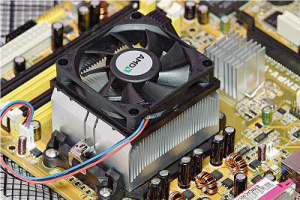Table of Contents
HEAT SINKS, FANS
Heat Sinks
As processors, graphics cards, RAM and other components in computers have increased in speed and power consumption, the amount of heat produced by these components as a side-effect of normal operation has also increased. These components need to be kept within a specified temperature range to prevent overheating, instability, malfunction, and damage leading to a shortened component lifespan. Other devices that need to be cooled include the power supply unit, optoelectronic devices such as higher-power lasers and light-emitting diodes (LEDs), and hard disks. (HEAT SINKS)
A heat sink is a heat exchanger component attached to a device used for passive cooling. It is designed to increase the surface area in contact with the cooling fluid surrounding it, such as the air thus allowing it to remove more heat per unit time. Other factors that improve the thermal performance of a heat sink are the approach air velocity, choice of material usually an aluminum alloy due to its high thermal conductivity values (229 W/mºK), fin (or other protrusion) design, and surface treatment. (heat sinks)

heat sinks

Figures: Above A fan-cooled heat sink on the processor of a PC. To the right of it is a smaller heat sink cooling another integrated circuit of the motherboard. Below 3 types of Heat-sink design: Pin, Straight (running the entire length of the heat sink), Flared.
heat sinks
The approach air velocity depends on the attached or nearby fan. When there is no airflow around the heat sink, energy cannot be transferred. A computer fan is any fan inside, or attached to, a computer case used for active cooling, and may refer to fans that draw cooler air into the case from the outside, expel warm air from inside,
or move air across a heat sink to cool a particular component. (heat sinks)
Case:
A computer case (also known as a computer chassis, cabinet, box, tower, enclosure, housing, system unit, or simply case) is the enclosure that contains most of the components of a computer (usually excluding the display, keyboard, and mouse). If you are building your own computer selecting the case will be one of your first choices to make: the type of case, its size, orientation, the number of bays you will need, etc.

Figure: shows a stripped ATX desktop case. The motherboard will lie flat on the bottom, against the right panel, with peripheral connectors protruding through the rear panel, drive bays at the top and front, and the power supply at the top and rear.
Sizes
Cases can come in many different sizes (known as form factors). The size and shape of a computer case are usually determined by the form factor of the motherboard since it is the largest component of most computers. Consequently, personal computer form factors typically specify only the internal dimensions and layout of the case
For example, a case designed for an ATX motherboard and power supply may take on several external forms, such as a vertical tower (designed to sit on the floor, height > width) or a flat desktop (height < width), or a pizza box (height ≤ 2 inches, designed to sit on the desk under the computer’s monitor). Full-size tower cases are typically larger in volume than desktop cases, with more room for drive bays and expansion slots. Desktop cases and mini-tower cases designed for the reduced microATX form factor are popular in business environments where space is at a premium.
Major Component Locations:
- The motherboard is usually screwed to the case along its largest face, which could be the bottom or the side of the case depending on the form factor and orientation.
- Form factors such as ATX provide a back panel with cut-out holes to expose I/O ports provided by integrated peripherals, as well as expansion slots which may optionally expose additional ports provided by expansion cards.
- The power supply unit is often housed at the top rear of the case; it is usually attached with four screws to support its weight.
- Most cases include drive bays on the front of the case; a typical ATX case includes a 5.25″ bay (used mainly for optical drives) and 3.5″ bays used for hard drives, floppy drives, and card readers.
- Buttons and LEDs are typically located on the front of the case; some cases include additional I/O ports, temperature, and/or processor speed monitors in the same area.
- Vents are often found on the front, back, and sometimes on the side of the case to allow cooling fans to be mounted via surrounding threaded screw holes.
| Motherboard | PC POWER SUPPLY | heat sinks |
This post contains the content of book Computer Hardware_ Hardware Components and Internal PC Connection
